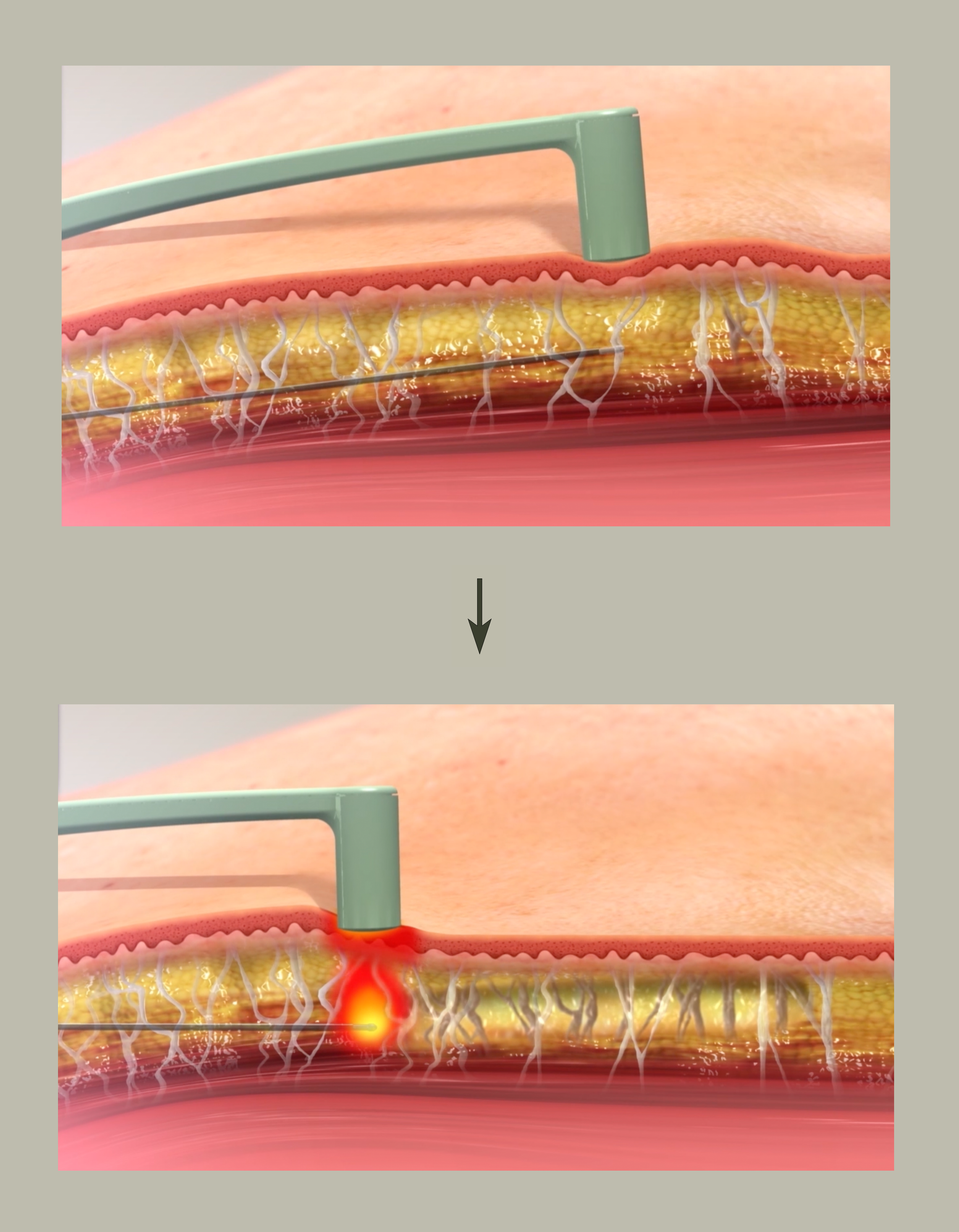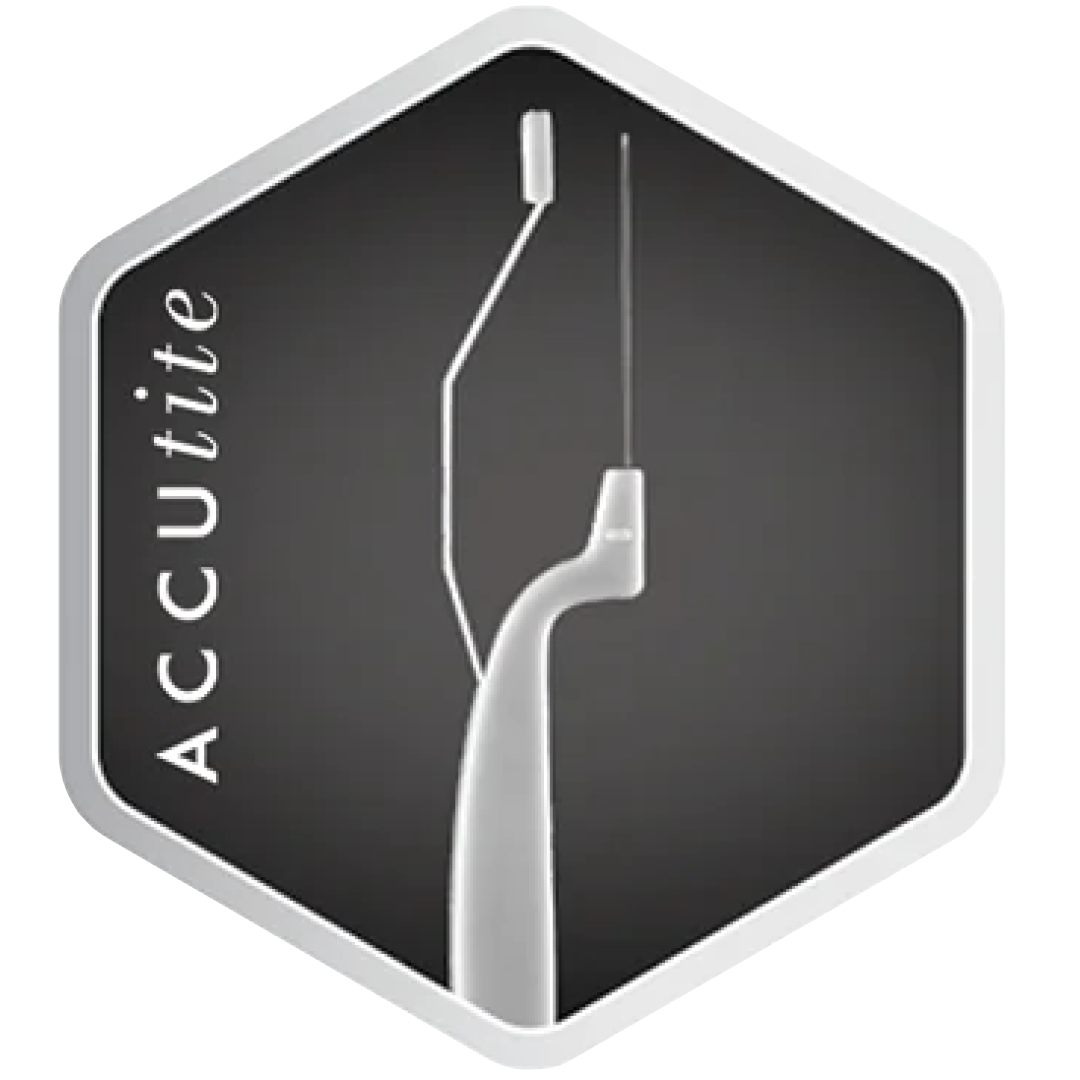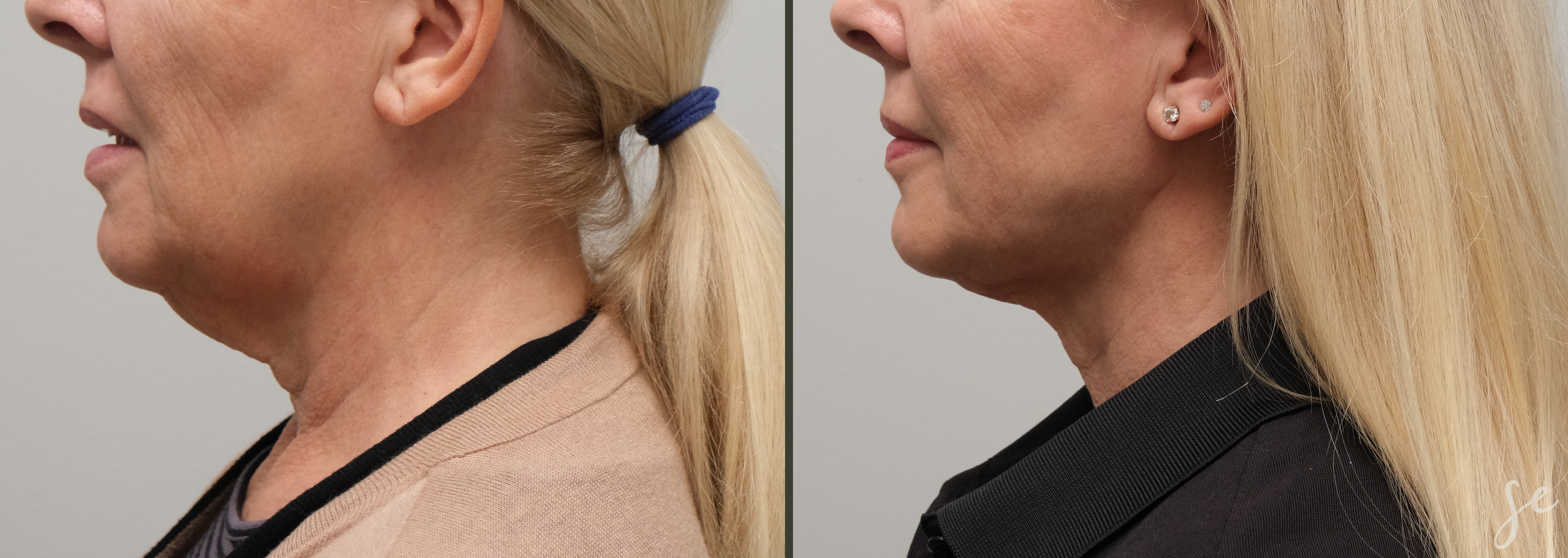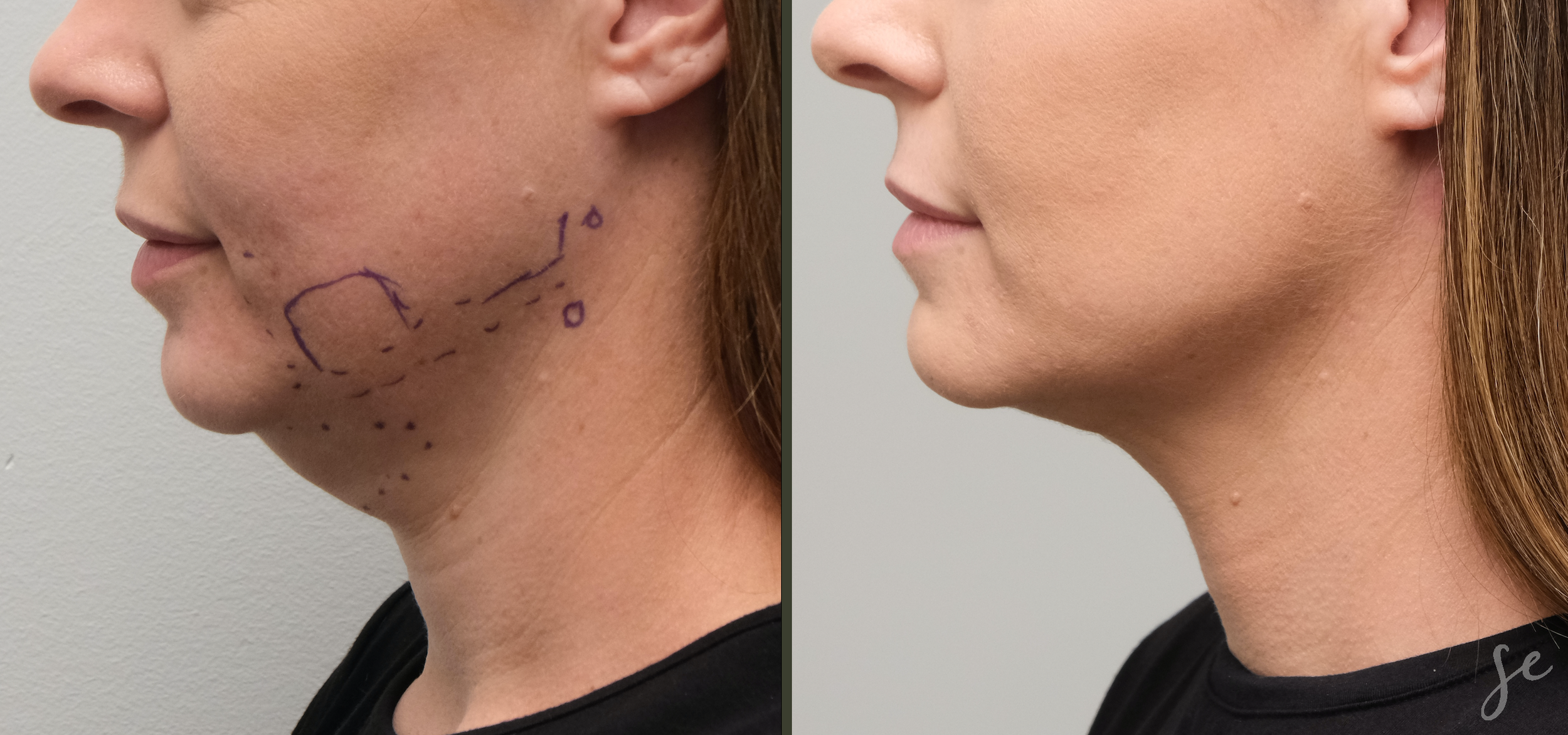FACETITE
FaceTite is a procedure that recruits the body’s own regenerative mechanisms to tighten drooping skin on the face and neck. In some cases it may be considered as a non-surgical alternative to a facelift or neck lift.
WHAT IS FACETITE?
FaceTite is a minimally invasive procedure that uses bipolar radiofrequency technology to tighten skin and the supporting ligaments. There is no skin excision, and the procedure is performed under local anaesthetic in the clinic.
A specially-designed cannula (small probe) is introduced under the skin through a needle entry point. A small electrode at the tip delivers radiofrequency energy into the tissue. This generates controlled heat through the skin and sub-skin layers, which activates the body’s own regenerative mechanisms. As a result, collagen production is stimulated and skin contraction occurs over a period of 12 months.
WHAT IS IT USED FOR?
FaceTite can be used to improve:
- Jowls & heavy marionette lines
- Jawline heaviness and loss of definition
- Under chin and neck heaviness or laxity
- Under eye bags
- Skin texture, crepiness and laxity
It is important to note that there are a variety of causes for the facial concerns listed above, and therefore a consultation with Dr Ellis is needed to assess your facial structure and assess whether you may benefit from FaceTite. FaceTite can be used as a standalone procedure, or in combination with other complimenting procedures depending on your facial anatomy. FaceTite may be combined with microcannula liposuction, fat transfer to face, Morpheus8, upper eyelid lift (blepharoplasty) or laser skin resurfacing depending on the aesthetic goal.
WHAT IS ACCUTITE?
AccuTite is the smaller version of the FaceTite handpiece, often used for the upper face. Both handpieces use the same technology and Dr Ellis will select the handpiece required for your individual anatomy.
You can see the differences in appearance of the two handpieces on Dr Ellis’ AccuTite page.
FAQs
-
Pre-procedure photos will be taken, following which Dr Ellis will measure and mark your skin to map out the treatment area.
Local anaesthesia is injected to numb the area before the procedure begins. The anaesthetic technique uses a large amount of fluid, so the area usually feels swollen and strange.
A cannula (small probe) is introduced under the skin to deliver the radiofrequency energy. During this part of the procedure pressure may be felt and there may be a velco-like sound as the heat contracts the tissue. This may be disconcerting for some, but due to the local anaesthetic there is no pain.
Following this, Dr Ellis almost always combines FaceTite with the use of Morpheus8 Fractional RF. This device works much in the same way as the FaceTite cannula, except it focuses heat closer to the surface of the skin to further stimulate collagen production in the skin itself. While it is not a standard part of the FaceTite procedure, Dr Ellis’ experience is that the inclusion of Morpheus8 creates greater skin contraction and remodeling.
Depending on the area treated and volume of tissue, treatment time for this procedure varies between 1 and 2 hours. Treatment time may be longer if other treatments are concurrently performed.
It is recommended that a friend or family member to drive you to and from your procedure. This is required if your procedure involves the area around the eyes or if you have requested an anxiety-reducing medication as part of your procedure as you will not be safe to drive.
-
Following the procedure you will be swollen, and some muscles in the treated area may not function properly for 6-18 hours due to the local anaesthetic. Depending on the area treated, you may be fitted with a compression garment to reduce swelling and bruising. This is used for 3 days and nights, followed by 3 nights only (ie; not worn during the day).
In the first 48 hours after your procedure you may feel some discomfort and mild pain - Dr Ellis provides medication for this. You may also experience a small amount of anaesthetic fluid leakage from the small entry points, so it can be useful to cover your pillow with a towel. This resolves within 24 hours.
The entry points are approximately 2mm in size and initially appear pink. These improve over several months and usually become barely noticeable (though individual variation does occur).
-
Although people often feel comfortable and well after the procedure, most people return to their normal activities when the swelling has subsided around 7-10 days after the treatment. This procedure requires recovery time, and every person’s recovery is different - it is always better to schedule for more downtime than you think you will need.
After 7-10 days there is usually still a low level of residual swelling that persists for some time while your body remodels your tissue. While this low level of swelling may be noticeable to you, it is often imperceptible to others. As your tissue remodels, it is common for the area to feel tight, as well as firm and lumpy to the touch. This is expected as part of the recovery process, and can persist for 2-3 months following treatment.
Lymphatic massage sessions can help decrease the firmness and lumpiness of the healing area, and may be commenced 14 days following the treatment if desired. It is important to note that lymphatic massage does not change the final outcome of the procedure, but can help with swelling and appearance during the remodeling phase.
-
Post procedure, you will be provided with appointments for two reviews.
5-7 days following your procedure, you will be reviewed by our nurse. During this appointment your wounds will be reviewed and you will be placed under our low-level healing laser (photobiomodulation therapy). This helps accelerate the healing process & reduces inflammation.
You will also be booked for a 3-month review with Dr Ellis. During this review your before and after images will be reviewed. While the final result will not yet be visible, Dr Ellis will be able to assess your skin-tightening trajectory.
Of course, during the period of your recovery you have complete access to Dr Ellis and our nurse. You are more than welcome to visit the Studio and consult with Dr Ellis or our nurse during the recovery period should you have any questions, concerns or wish to be reviewed. These appointments are all provided free of charge as part of your post-procedure care.
-
The final results of FaceTite are usually seen 12 months after the procedure.
Unlike surgery or fillers where an immediate structural change is produced, FaceTite stimulates the body's own regenerative processes to restructure and produce its own collagen. While this doesn’t produce an immediate result, an ongoing benefit and improvement is experienced as the body builds its response.
Some improvement can often be appreciated around 8 weeks after your procedure, but the full skin-tightening effect often takes 12 months to see.
-
As with every skin-based procedure, while FaceTite can create improvements it does not stop the process of ageing. Future procedures or treatments may be necessary to retain your results over time.
On average, upper face procedures may need to be repeated every 3-5 years, with lower face procedures tending to be repeated every 5-10 years. Individual timeframes, however, may vary.
-
Every medical procedure has associated risks and uncertainty. It is important that you understand these risks in order to make an informed decision. Any risks specific to you will be discussed with you during your consultation, but general risks include:
- Skin irregularities: lumps, bumps, or skin tethering may occur.
- Burns: this is a risk that is associated with any energy based device. Thermal injury to the skin that may require further treatment such as dressings or excision.
- Asymmetry or inadequate outcome: FaceTite relies on activating the body’s own regenerative mechanisms, and the results will therefore vary from person to person. A guarantee of perfect symmetry or any specific outcome is not possible.
- Scarring: entry site scars are usually small (approximately 2mm) and not visible once mature but excessive, undesirable, or visible scarring may occur (particularly after a complication such as a burn).
- Infection (rare): infection is rare, but possible with any procedure that disrupts the skin barrier.
- Temporary nerve injury: Injury to larger nerve branches of the face may cause asymmetry of the smile or facial movement. This is not permanent, but may take anywhere from 2 weeks to 6 months to resolve fully. This occurs in 0.5-1% of cases.
- Blindness (theoretical risk, never reported): If treating underneath the eyes, a theoretical risk of blindness exists secondary to bleeding behind the eye (retrobulbar haematoma). It has never been reported with this procedure, but is a known risk with surgeries performed in the area.
-
Consultations with Dr Ellis are $125. There is no Medicare rebate for this consultation.
As the procedure is customised for every person depending on their individual needs, the cost for the procedure varies. The cost to address the common concerns outlined above can range between $3,000 - $7,500. You will be provided with a formal fee estimate following your consultation.
-
If you have any of the facial concerns outlined above, FaceTite may be of benefit to you. To assess whether this procedure may be of benefit for your specific situation, Dr Ellis will complete a comprehensive assessment. During your consultation you will learn what may be contributing to your individual concerns, as well as what treatment options are reasonable for you to consider, which might help you to decide whether this treatment may be right for you.
FACETITE AND OTHER PROCEDURES
-
FaceTite is sometimes combined with microcannula liposuction, facial fat transfer, eyelid lift (blepharoplasty), platelet rich fibrin or laser skin resurfacing depending on your concerns, tissue quality and the aesthetic goal.
-
There are a number of alternative options to FaceTite.
Laser treatments are able to improve skin quality and may create some associated contraction. Similarly, Morpheus 8 RF microneedling may produce more contraction of the skin than laser therapy, but is less invasive than FaceTite. Neither of these options allow reduction of excess fat volume.
These options are less invasive than FaceTite and, although less effective, may create results that you are satisfied with. Dr Ellis is always happy to discuss your options during consultation.
Facelifting surgery (with or without liposuction) is another option for correcting facial sagging. It is a more invasive procedure that may bring benefit to you, should you find the risk profile acceptable. If considering facelift as an alternative, Dr Ellis recommends consultation with a qualified facelifting surgeon prior to making a treatment decision, and can provide recommendations for consultation.
-
Both FaceTite and facelift surgery can be used to reduce the signs of aging caused by sagging skin on the face and neck. However, there are several key differences between these procedures which impacts the cosmetic outcome and who they may be suitable for.
During facelift surgery, larger incisions are made to access the deeper layers of the face. Excess skin is excised and the remaining skin and muscle is pulled to create a lifting effect for sagging tissue. These surgeries are usually performed under a general anaesthetic or intravenous sedation, and sometimes require a 1-2 night stay in hospital. Although specific details depend on the type of facelift surgery, in general people can often return to work 14 days after surgery, can return to light exercise by 2 weeks and more strenuous activity after 6 weeks.
Facelift surgery is a more invasive procedure with slightly longer downtime, is generally more expensive than FaceTite, but also produces more pronounced results. Similar to FaceTite, facelift surgery does not produce permanent results as neither procedure stops the ongoing aging process that occurs within all tissues. In general, the effects from facelift surgery last around 10 years, depending on the technique used.
FaceTite uses radiofrequency energy to treat the skin and supporting structures, but not the muscle and deeper layers. This results in several key differences in outcomes. FaceTite induces rejuvenation of the skin quality as the body responds to the radiofrequency energy and produces its own collagen. When facelift surgery is performed alone (i.e. no laser resurfacing), while excess skin is removed, the skin quality is unchanged. With facelifting, there is also a true ‘lifting’ effect as the skin and muscle is pulled upwards. With FaceTite the skin and supporting structures are tightened, and therefore have less sagging, but do not have a ‘lifted’ effect. FaceTite therefore often produces a less dramatic effect, but appears more natural to friends and family as the skin contracts over a 12 month period.
Compared to facelift surgery, FaceTite is less invasive (only treating the skin and the supporting structures beneath but not the muscle layer), and generally has smaller scars and a shorter recovery period. As FaceTite is performed under local anaesthetic, it does not have the risks associated with a general anaesthetic. It is also performed in the clinic as opposed to hospital, which also reduces the overall cost of the procedure.
As everyone has different anatomy and expectations, it is always recommended to discuss your unique situation with a doctor. During your consultation with Dr Ellis, he will assess your anatomy and recommend whether he thinks FaceTite may be of benefit to you. If facelifting surgery is even a remote option for your, Dr Ellis recommends also consulting with at least one facelifting surgeon to understand your treatment options fully.
If Dr Ellis thinks that facelift surgery may be more appropriate, or if he believes you would benefit from understanding facelift in detail prior to making any decisions, he can provide recommendations for a consultation so you can decide what is best for you.
-
Morpheus8 is a treatment using fractional radiofrequency microneedling that aims to contract skin. Morpheus8 works on similar principles to FaceTite of using radiofrequency to heat tissues to stimulate skin contraction and collagen production.
The main difference between Morpheus8 and FaceTite is that Morpheus8 delivers the radiofrequency more shallowly to the skin, whereas FaceTite delivers energy to the deeper supporting structures of the skin. This means that Morpheus8 can sometimes be used alone for skin contraction if there is no excess drooping fat tissue, but FaceTite is usually more appropriate if the deeper layers need to be addressed.
Dr Ellis frequently uses these two treatments in conjunction with each other.
BEFORE & AFTERS
All images shown are Dr Ellis’ own procedural work.
Consent has been provided by all patients for these photos to be shown.
These images are indicative only and reflect the results for these individual patients. Results vary from person to person.















